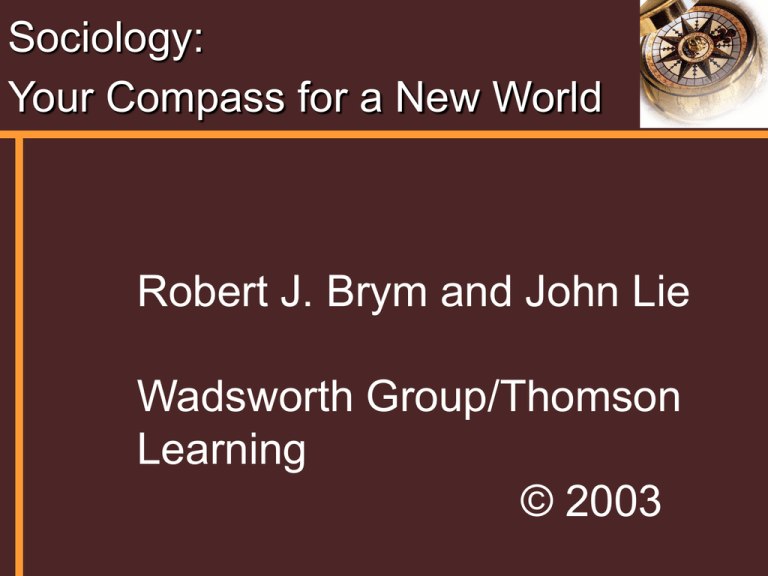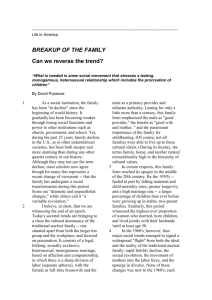
Sociology:
Your Compass for a New World
Robert J. Brym and John Lie
Wadsworth Group/Thomson
Learning
© 2003
Chapter 12
Families
The Traditional Nuclear Family
The Traditional Nuclear Family Is
Composed of
A Father-provider
A Mother-homemaker
At Least One Child
The Decline of the
Traditional Nuclear Family
Today, Only a Small Minority of American Adults
Live in Traditional Nuclear Families.
Many Different Family Forms Have Proliferated
in Recent Decades.
The Frequency of These Forms Varies by
Class, Race, and Sexual Orientation.
Household Types, U.S.A.,
1940-98 (in Percent)
100
80
married couples
60
40
non-family
20
other family
0
1940
1950
1960
1970
1980
1990
1998
Year
Note: “Non-family” households contain people living alone or with non-relatives. “Other family”
households are mainly female-headed, single-parent families.
Source: U.S. Bureau of the Census (1999a).
The Functionalist Theory
of the Family I
According to Functionalists, the Nuclear Family
Is the Universal Family Form Because It Provides
an Ideal Setting For
Sexual Regulation
Economic Cooperation
Reproduction
Socialization
Emotional Support
The Functionalist Theory
of the Family II
In Foraging Societies, the Band and Not the
Nuclear Unit Is the Main Locus of Socialization
and Economic Functions
Gender Relations Are Egalitarian.
Although the Traditional Nuclear Family
Became Entrenched in America in the 1950s, It
Has Been in Decline Since the 19th Century.
Marriages and Divorces, U.S.A.,
1940-98 (Per 1,000 Population)
20
15
marriage rate
10
5
divorce rate
0
40
9
1
50
9
1
60
9
1
70
9
1
Year
80
9
1
Sources: Monthly Vital Statistics Report (1995a; 1995b;
1998); National Vital Statistics Reports (1999b).
90
9
1
00
0
2
Marxism and Feminism
Marxists Stress How Families Operate to
Reproduce Class Inequality.
Feminists Stress How Families Operate to
Reproduce Gender Inequality.
Mate Selection
Mate Selection Is Influenced by
Marriage Resources (the Assets Potential
Spouses Bring to the Marriage Market)
The Influence of Third Parties
Demographic and Compositional Factors
Group Size,
Geographical Concentration,
Sex Ratio,
Heterogeneity of Local Marriage Markets
The Components of Love
Passion
Commitment
Intimacy
Source: Sternberg (1986).
Time
Effects of Increased Female Labor
Force Participation
The Entry of Women Into the Paid Labor Force
Increased Their Power to
To Leave Unhappy Marriages
To Control Whether and When They Would
Have Children
It Did Not, However, Have a Big Effect on the
Sexual Division of Labor in Families.
Marital Satisfaction
Marital Satisfaction Is Lower
At the Bottom of the Class Structure
Where Divorce Laws Are Strict
When Children Reach Their Teenage Years
In Families Where Housework Is Not Shared
Equally
Among Couples Who Do Not Have a Good
Sexual Relationship
Family Satisfaction and the Family
Life Cycle, U.S.A., 1998
Family satisfaction (scale 1-5)
4.5
4.3
Men
4.1
3.9
Women
3.7
ts
n
re
a
-p
n
No
49
25
Source: Keller (2000).
ng
i
ch
n
u
La
t
en
m
h
s
bli
a
t
Es
en
r
ild
h
C
t
l
u
Ad
y
pt
Em
t&
s
Ne
ts
n
re
a
p
no
N
+
50
Effects of Divorce I
Common Effects of Divorce Include
A Rise in the Husband’s Income and a
Decline in the Wife’s
The Development of Behavioral Problems
Among the Children of the Divorcing Couple
The Economic Aftermath of Divorce,
U.S.A., by Sex, 1991 (in millions)
Custodial Parents
Awarded Support
Women
Men
Received Part
Received Nothing
In Poverty
0
2
4
6
Millions of People
Source: Scoon-Rogers and Lester (1995: 7).
8
10
Effects of Divorce II
Most of the Emotional Distress Experienced by
the Children of the Divorcing Couple Is Due to
A High Level of Parental Conflict
A Decline in Living Standards
The Absence of a Parent
No Parental Conflict and Stable Living
Standards Can Eliminate Most of the Emotional
Distress Experienced by the Children of the
Divorcing Couple.
Reproductive Choice
The Power Women Gained From Working in the
Paid Labor Force Put Them in a Position to Exert
More Control Over Their Reproductive Functions
Through
Contraception and Abortion
Reproductive Technologies, Including
Artificial Insemination
Surrogate Motherhood
In Vitro Fertilization
Screening Techniques
Housework and Wife Abuse
Men Now Take a More Active Role in the Day-today Running of the Household but the Change Is
Modest, With American Men Now Doing 25-30% of
Housework and Childcare on Average.
Equality in Domestic Labor Increases When the
Income of the Spouses Is More Equal and When
the Spouses Agree That It Should Be More Equal.
Gender Equality Also Lower the Rate of Wife
Abuse.
The Division of Domestic Labor by
Woman’s Work Status, U.S.A., 1987-88
Hours per week on chores
60
50
40
Men
Women
30
20
10
0
at home
in labor force
first marriage
at home
in labor force
stepfamily
Labor Force Status of Woman and Family Type
Source: Demo and Acock (1993: 329).
Spousal Violence Against Wives,
U.S.A., 1968-94 (in Percent)
25
Wife
assault
rate
(%)
approves
husband
slapping
wife
20
15
minor
assaults
by
husband
10
5
0
1968
1975
1985
1992
Year
Note: Figures include cohabiting but unmarried couples.
Source: Straus (1995).
1994
severe
assaults
by
husband
Sexual Orientation
and Family Diversity
In Many Places, the Legal and Social Definition
of “Family” Is Being Broadened to Include
Cohabiting, Same-sex Partners in Long-term
Relationships.
Growing up in a Lesbian Household Has No
Known Negative Effects on Children.
U.S. States With Laws Banning
Same-sex Marriages, 2000
Source: National Gay and Lesbian Task Force (2000).
The Decline of Two-parent
African-American Families
Two-parent Families Are Less Common Among
African-American Families Due to
High Unemployment Among AfricanAmerican Men
The Declining Ratio of Eligible Black Men to
Women
The Falling Earning Power of AfricanAmerican Men Versus the Rising Earning
Power of African-American Women
Families With Own Children Under 18 by
Race and Hispanic Origin, U.S.A.,1970-97
Percent
100%
Twoparent
75%
50%
Singlemother
25%
0%
W
te
hi
,
7
19
0
W
te
hi
,
8
19
0
W
te
hi
,
9
19
7
Hi
ic
n
a
sp
,
8
19
0
Hi
ic
n
a
sp
,
9
19
7
k,
c
a
Bl
7
19
0
k,
c
a
Bl
8
19
0
9
19
7
k,
c
a
Bl Group/Year
Note: 1970 data on Hispanics and single-father families are not available.
Source: Baca Zinn and Eitzen (1993: inside back cover); Bryson and Casper (1998: 4).
Poverty and Minority Families
Poor African-American Women Have Developed
Strong Kinship and Friendship Networks That
Enable Them to Survive With Few Resources
Poor Hispanic-American Families Rely Heavily
on Extended Kin Networks for Social Support
This Tendency Declines As Migration Status
Changes and People Experience Upward
Mobility
Family Policy
People Sometimes Blame the Decline of the
Traditional Nuclear Family for Increasing
Poverty
Welfare Dependence
Crime
However, Some Countries, Such As Sweden,
Have Adopted Family Support Programs That
Largely Prevent These Problems





